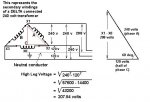teufelhounden91
Senior Member
- Location
- Austin, TX, USA
I'm new to the forum, but am a Journeyman Electrician in Austin, TX. I'm starting to learn about transformers and I've searched the hell out of this site for an explanation that I understand but to no avail...
My Question:
How does a Delta High Leg get 240V from leg to leg, but get 208V from the High Leg to Ground, when the other Legs get 120V to Ground?
I know there's a calculation - 120V x 1.73 = 208...but that equation doesn't explain the HOW I guess. Every diagram I see of Delta transformers make visual sense to me...but how does it happen? If there's 240V from A to B, and B to C...shouldn't all 3 legs have the same voltage to ground?
I still don't really know why Wye transformers have a ground and Delta's do not so maybe that's where my lack of understanding lies.
Thanks for any info you have!
My Question:
How does a Delta High Leg get 240V from leg to leg, but get 208V from the High Leg to Ground, when the other Legs get 120V to Ground?
I know there's a calculation - 120V x 1.73 = 208...but that equation doesn't explain the HOW I guess. Every diagram I see of Delta transformers make visual sense to me...but how does it happen? If there's 240V from A to B, and B to C...shouldn't all 3 legs have the same voltage to ground?
I still don't really know why Wye transformers have a ground and Delta's do not so maybe that's where my lack of understanding lies.
Thanks for any info you have!


